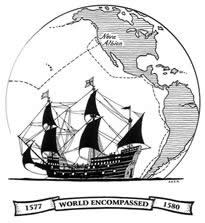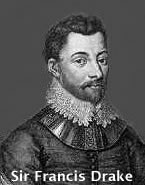 Press Release
Press Release
October 17, 2012
Drake Navigators Guild
San Francisco, California
The Drake Navigators Guild thanks Secretary of the Interior Ken Salazar for creating The Drakes Bay Historic and Archaeological District National Historic Landmark which gives formal recognition to Francis Drake’s landing site at Drake’s Cove in 1579, the shipwreck and encampment of Sebastian Rodriguez Cermeño in 1595, and fifteen Native-American villages associated with sixteenth-century Native encounters with the European explorers. These places are now identified as the locations of significant events in the land that would, in time, become the United States of America.
At Drakes Bay, Englishmen made their first claim and had their first encampment on this land. Here, they held the first service from The Book of Common Prayer. Here, the first shipwreck of a Manila galleon occurred on our shores. Here, Native-Americans of the Coast Miwok People first interacted with Englishmen and Spaniards.
The establishment of the National Historic Landmark (NHL) recognizes that the sites are “nationally significant in American history and culture.” Nation-wide, fewer than 2,600 such sites are recognized by the Department of the Interior and the National Park Service.
............................................................................................................................................................
Francis Drake landed at Drakes Bay on June 17, 1579 (June 27 by the modern calendar), and stayed for thirty-six days. This was a repair and replenishment stop on his ‘round-the-world voyage of raiding and exploration. During his stay, he maintained friendly and respectful relations with the Native Americans, although the two cultures had scant understanding of each other’s lifeways. From Drakes Bay, Drake sailed his Golden Hind to the Farallon Islands, where his crew stocked up on birds’ eggs and seal meat -- and became the first European visitors to a part of San Francisco. Drake sailed west, through the East Indies and around Africa, and arrived in Plymouth, England, a year later with the treasures he had taken from the Spaniards off the west coast of South and Central America. This completed the second circumnavigation, and the first to be accomplished by its commander, Magellan having died in the Philippines. Queen Elizabeth rewarded Drake’s achievement with knighthood.
Sixteen years later, Sebastian Rodriguez Cermeño’s galleon San Agustin reached Drakes Bay from Manila. His crew began to assemble a boat on the beach, intending to use it for coastal exploration on the way to Mexico, but a November storm drove the ship to destruction in the shallows and the survivors sailed to Mexico in the boat. This is the earliest Manila galleon wreck on the coast of the United States. Cermeño also interacted with the Miwok People.
............................................................................................................................................................
The Drake Navigators Guild is a private nonprofit organization founded in 1949 and devoted to research about the sixteenth-century contacts with our shores. Guild members identified Drake’s Cove, within the entrance of Drakes Estero and facing Drakes Bay, as Drake’s harbor in 1952. They, and associated scholars from around the world, have conducted research in fields as diverse as cartography, navigation, shipbuilding, zoology, botany, hydrology, Chinese porcelains, Native-American culture, and disease at sea -- all relating to the fifty or so detailed clues to Drake’s visit contained in the explorer’s records and to wider studies of all the explorer contacts along the Pacific Coast.
The Guild is grateful for the decades of research of the sailor-scholars such as Captain Adolph Oko, Jr.; Captain Raymond Aker; Fleet Admiral Chester W. Nimitz; Rear Admiral Samuel Eliot Morison; Captain Daniel Dillon; Admiral Sir Simon Cassels; Lieutenant Matthew Dillingham; Captain Alan Villiers; Robert Lynch; and Lieutenant Commander F. Richard Brace; and to the land-based researchers such as Robert W. Allen; Robert Parkinson; Colonel Herbert E. Garcia; Don Thieler; Ernest W. Michelsen; William J. Duddleson; Dr. John Sugden; Bruce Keegan; Dr. Matt Russell; Clarence Shangraw; Dr. Barry M. Gough; Michael Turner; Dr. Samuel Spivack; and Edward Von der Porten. Many more, too numerous to list, have contributed through the years, and new generations of researchers are adding to the work.
The bar for establishing any National Historic Landmark is set very high. The research for the Drakes Bay Historic and Archaeological District was extensively reviewed by National Park Service historians and anthropologists, and by numerous independent scholars at the Park Service’s request, for more than a decade. The Guild is grateful to all of them for their painstaking analyses and especially to the Service’s nautical historian Kevin Foster and anthropologist-archaeologist Dr. Erika Martin Seibert who managed the Landmark nomination process in Washington.
The Guild also is grateful to the Marin County Board of Supervisors for twice endorsing the recognition of the Drake landing site, to Congresswoman Lynn Woolsey and her staff for supporting the nomination, and to the many scholars who sent letters of support to the National Parks Service.
The National Parks Advisory Board’s Landmarks Committee met in Washington, D.C., in November 2011. The Drakes Bay Historical and Archaeological District nomination was well received and unanimously approved. Especially gratifying was the praise for the research from Committee member and archaeologist Dr. James M. Alan of Lafayette, California.
The National Parks Advisory Board met in Key Largo, Florida, in December 2011. Again, the nomination was well received and earned a unanimous vote in favor of the National Historic Landmark designation. From there, it went to Secretary of the Interior Ken Salazar for his signature.
A formal placement of a bronze plaque identifying the Landmark likely will be scheduled in the coming months.
The decision to create this National Historic Landmark is an important milestone in the Guild’s more than six decades of historical research and publication. Fleet Admiral Nimitz’s 1956 statement, “I do not doubt that in time the public will come to recognize the importance and value of this long-lost site [Drake’s Cove], and will rank it with other National Historic Sites such as Roanoke, Jamestown, and Plymouth,” has come true.
............................................................................................................................................................
An eighty-page book about Drake’s voyage and California visit is available at the National Park Service’s Bear Valley Visitors Center in the Point Reyes National Seashore or from the Guild.
The Drake Navigators Guild is a not-for-profit 501(c)(3) research corporation.
Edward Von der Porten, President
Drake Navigators Guild
143 Springfield Drive
San Francisco, CA 94132-1456 U.S.A.
415-664-7701
edandsaryl@aol.com
On the web:
http://www.nps.gov/nhl/Fall11Noms/DrakesBayES.pdf
http://www.nps.gov/nhl/Fall11Noms/RedactedDrakesBay.pdf
http://www.drakenavigatorsguild.org/
http://www.nps.gov/pore/planyourvisit/visitorcenters.htm#CP_JUMP_63132
Presentation at the NHL meeting in Washington, DC, November 2011
Slides at the NHL meeting in Washington, DC, November 2011
Home
The Guild
Drakes's
Life
Drake's
Portrait
Circumnavigation
California
Landings
Guild Booklet
Press
Release
Publications

Copyright © DNG 2003-2016
- Updated: 18 July 2016
